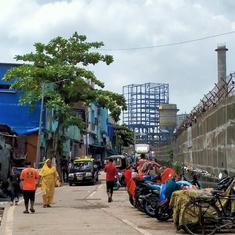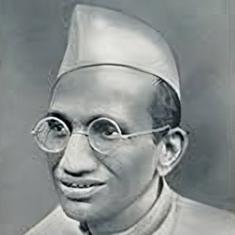It is a standard sight on Ashtami afternoons in Kolkata. Outside neighbourhood puja pandals, young dada-boudis and elderly kaku-kakimas wait in the stifling heat, with infectious enthusiasm and withering patience, while youngsters, their volunteer badges in place, lay out sal leaf plates on narrow tables with wobbly legs.
Behind the mandap, in makeshift tents, sweaty, gamchha-clad cooks vigorously stir giant pots of runny khichuri, and fish out piping hot begunis (aubergine fritters) or misshapen luchis from bubbling oil and toss them into mammoth straw baskets, with a seasoned flick of the hand. Meanwhile, the designated emcee (every puja committee has one) pleads into the microphone – “Maintain order, please”.
The hurried, slightly chaotic meal that follows is, above all, a celebration of community and camaraderie, the essence of Durga Puja. That, and the Bengali’s love for Bhog’er Khichuri.

Durga Puja’s bhog is almost synonymous with khichuri – a savoury combination of dal and rice – and vegetarian accompaniments such as beguni or lyabra. But, as food anthropologist and consultant Pritha Sen explains, the bhog served at community (barowari or sarbojanin) pujas is standardised vegetarian fare “for the benefit of the diverse public who attend”. It hardly represents the extraordinarily varied ritualistic cuisine offered to Goddess Durga across Bengal.
Indeed, Durga’s Bhog need not be vegetarian at all.
The Shakto tradition of worship, for instance, approves the inclusion of meat and fish. At the four-centuries-old Durga Puja at the Kolkata house of the Sabarna Roy Choudhury family, the elaborate mahabhog includes a variety of fish – fried, rich curries and mustard gravies – along with dishes like pulao, a range of curried or deep fried vegetables and payesh (rice pudding).
Sen remembers the unique jhol’er bannyon – a light curry made with a medley of vegetables like banana stem, pumpkin, unripe bananas and ash gourd, fish heads and some shrimps – she sampled at another household puja in Kolkata.
Historically, Sen says, the tradition of Matsyamukh (ritualistic offering of fish) was more prominent in riverine East Bengal (present-day Bangladesh), where fish is a symbol of plenty and deeply entrenched in its people’s ethos. In West Bengal, on the other hand, Vaishnav traditions, which advocate strictly vegetarian bhog, were popular.
One tradition that sanctions, even emphasises, the offering of blood to the Devi through ritualistic animal sacrifice is the Tantric school of worship. The bali is performed during the auspicious Sandhi Puja, the sacred juncture when Ashtami ends and Navami begins, when Durga is worshipped as the fierce Chamunda, the slayer of demons Chanda and Munda. The meat of the animal sacrificed is served to the devotees. This meat (usually goat) is cooked without a trace of onion or garlic. Instead aromatic whole spices, ginger and cumin paste, are used in this dish curiously named Niramish Mangsho (vegetarian meat).
Caste tabooos
Another interesting aspect of bhog cuisine is the Shital (cold) bhog. In his 1931 book The Cultural Significance of Fish in Bengal, anthropologist Tarak Chandra Das writes how in the Dacca district of East Bengal, a meal comprising “boiled rice kept overnight immersed in water” and “chutney prepared with lotus stalk and the soup of boal-fish (Wallago-attu)” would be served on the final day of the Puja.
The tradition of serving panta bhaat (fermented rice) with accompaniments like khesari dal, kochusaag (taro stem) usually ground into a paste with grated coconut, lentil fritters, fish like koi or sol, and tangy chutney made with elephant apples (prepared a day in advance) on Dashami, is still prevalent in many a household.
However, not every household can offer cooked rice – be it khichuri, pulao or panta – as bhog. The reason for this echoes a widespread caste taboo.
Tirthankar Deb of the illustrious Shobhabazar Rajbari said, “We do not offer anna bhog [cooked rice] to Durga, since we are not Brahmins. Only Brahmins have that privilege.”
Like the Debs, numerous non-Brahmin households only offer uncooked rice in the form of Naividya with fruits and sweets. At the Jorasankho home of the Daw family, a Naividya of one maund (around 37 kilos) rice is offered, and then sent to an orphanage for differently-abled children.

In homes where annabhog is forbidden, the absence of khichuri is made up for with an assortment of sweetmeats and savouries like gaja, perakia stuffed with kheer, radhaballabi, nimki, ledikeni and more. Sweets and other delicacies are usually made at home by Brahmin confectioners equipped with recipes that have been passed down through generations. “At one point nearly a hundred different kinds of delicacies were offered as Bhog, in our family,” said Deb. “Many of these recipes are now lost.”
Underneath the rituals, there is an intimate note to the bhog offered to the goddess. Quintessentially, Durga Puja is a private, familial affair, a moment that marks the homecoming of goddess Uma from her abode in Kailash. The mood, therefore, is one of happy reunion. The idea is to pamper her during her fugacious stay. This familial love best finds expression in the food offered to Durga.
Every home has a few unique dishes – from the mammoth, pristine white motichoor ladoos at the Shovabazaar Rajbari to the luxurious kheer infused with sandalwood at the Ghosh Bari in Pathuriaghata – specially prepared for the goddess in addition to the usual bhog entries.
"An inimitable dish I sampled at a centuries-old household puja, started in 1530, is chutney made with collocassia stem, jaggery, tamarind and panchphoran [Bengali five spice],” recalled Sen.
At the Mitra residence in North Kolkata’s Nilmoni Street, the only cooked food offered to the goddess is an austere meal of luchi fried in ghee and four kinds of deep fried vegetables, prepared without salt. This Naividya comes with a salver heaped with an assortment of bori (sun-dried lentil pellets), such as jhol’erbori (usually added to runny stews), Bhaja’rbori (tiny pellets eaten deep-fried), bori made with spinach, poppy seeds ground into a paste, peanuts, yellow split peas, Kalai or Biulir dal (black lentils) and split Bengal gram.
In addition to the bori, the Mitra residence prepares an array of homemade pickles – kul (plum), tentul (tamarind), aam (fresh mango) and aamshi (dried mango) – fermented in the sun.
“On Dashami, the women of the house must eat a meal comprising shukto, shaak, maachh and the prasadiachaar before they can perform the Baran [farewell rituals],” said Anasua Biswas, a member of the family.
Pickling or making bori are cherished seasonal rituals steeped in nostalgia that often feature in the culinary memoirs of Bengali homes, as tokens of happy domesticity. Offering bori and achaar underscores the “familial affection” – or what the Greeks would call storge – for a daughter that is the quintessence of Durga Puja for schmaltzy Bengalis.
In fact, the tradition of serving panta as bhog on the day of Durga’s departure is embedded in this domestic sentimentality. Some reason that saddened by their beloved Uma’s departure, no one is in a mood to cook. Others argue, “Durga is in such a hurry to return to her husband in Kailash (she is known to be equally anxious to return to her father’s home), there’s no time to cook a fresh meal.”










